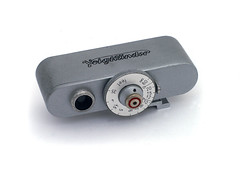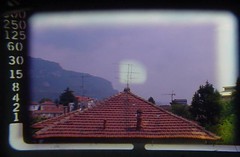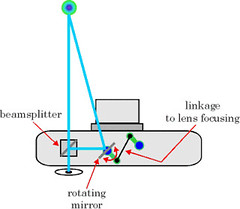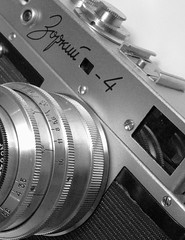Difference between revisions of "Rangefinder (device)"
m (minor rewording) |
(reworked existing words for more accuracy) |
||
| Line 1: | Line 1: | ||
| + | {{glossary}} | ||
| + | {{Flickr_image | ||
| + | |image_source= http://www.flickr.com/photos/captkodak/272750793/ | ||
| + | |image= http://farm1.static.flickr.com/92/272750793_24f344bc6c_m.jpg | ||
| + | |image_align= left | ||
| + | |image_text= Voigtländer rangefinder accessory<br>(viewing side) | ||
| + | }}A '''rangefinder''' is a distance-measuring device, used in photography as a focusing aid. Cameras equipped with this device are called [[rangefinder camera]]s. There are two types of rangefinder: a '''coupled rangefinder''' has a linkage to the distance ring of the lens and lets you focus on a subject directly with the lens's focusing ring, while an '''uncoupled rangefinder''' allows you to measure how far away you are from a subject, and then manually transfer the measurement to the camera's actual distance ring. Accessory uncoupled rangefinders may be used with almost any camera with a focusing lens. | ||
| + | {{br}} | ||
| + | === Operation === | ||
| + | {{Flickr_image | ||
| + | |image_source= http://www.flickr.com/photos/e-coli/327904794/ | ||
| + | |image= http://farm1.static.flickr.com/141/327904794_c8454dc23d_m.jpg | ||
| + | |image_align= right | ||
| + | |image_text= View through a viewfinder with<br>superimposed rangefinder image | ||
| + | }} | ||
| + | The viewfinder photo here shows how it is used; the rangefinder is a ''coincident focusing device'', which displays two separate images. The main image is the entire frame of the viewfinder, while the secondary image is a small spot in the center of the frame. To focus on something, you aim the spot in the center at that something, which shows the two images. By turning the focus adjustment, you move the secondary image horizontally until it lines up with the main image. At this point, the rangefinder (and so the lens, if coupled) will be focused on the selected object. | ||
| + | |||
| + | In the example (right) the light image area in the middle shows the antenna doubled. That indicates that a distance selection change is needed to make a sharp image of that antenna. When the antenna lies in the sharpness plane the rangefinder shows it just once. | ||
| + | |||
| + | === Construction === | ||
{{Flickr_image | {{Flickr_image | ||
|image_source=http://www.flickr.com/photos/10025600@N00/105571617/in/pool-camerapedia/ | |image_source=http://www.flickr.com/photos/10025600@N00/105571617/in/pool-camerapedia/ | ||
|image=http://farm1.static.flickr.com/43/105571617_6ba4bcce48_m.jpg | |image=http://farm1.static.flickr.com/43/105571617_6ba4bcce48_m.jpg | ||
|image_align=right | |image_align=right | ||
| − | |image_text=diagram of | + | |image_text=diagram of rangefinder structure |
}} | }} | ||
| − | + | The rangefinder works by combining two images, from two windows, into the image you see, using a ''beamsplitter''. This is a "half-silvered" prism or a mirror which can either split light, by reflecting some and allowing the rest to go straight through, or (in a rangefinder) used in reverse to combine views. The light from the second window is channelled via a mirror, prism or lens which rotates depending on the rangefinder setting - causing the secondary viewfinder image to move with the distance control. | |
| − | + | === Accuracy === | |
| + | Rangefinders are very accurate focusing devices over short distances - for camera rangefinders, typically up to about 10-15m (~30-40ft), actually more accurate than through-the lens focusing screens on [[SLR]]s. The accuracy depends on the effective ''[[rangefinder base]]'' - the distance between the viewing windows times the magnification of the viewfinder. Standard and wide-angle lenses are not very sensitive to focus from around 10m to infinity, so this limitation is not significant - unless using longer lenses. Rangefinders are not usually accurate enough for long, telephoto lenses - as these are more sensitive to focus at long distances, past where camera-sized rangefinders are effective. | ||
| − | |||
| − | |||
| − | |||
| − | |||
| − | |||
| − | |||
| − | |||
| − | |||
| − | |||
| − | |||
| − | |||
| − | |||
| − | |||
{{Flickr_image | {{Flickr_image | ||
|image_source= http://www.flickr.com/photos/martintaylor/367782286/ | |image_source= http://www.flickr.com/photos/martintaylor/367782286/ | ||
|image= http://farm1.static.flickr.com/144/367782286_8c3522b022_m.jpg | |image= http://farm1.static.flickr.com/144/367782286_8c3522b022_m.jpg | ||
|image_align= left | |image_align= left | ||
| − | |image_text= front of a rangefinder camera with characteristic little extra viewfinder window | + | |image_text= front of a coupled-rangefinder camera,<br>with characteristic little extra viewfinder window |
}} | }} | ||
| − | |||
| − | |||
| − | |||
| − | |||
| − | |||
| − | |||
| − | |||
| − | |||
| − | |||
| − | |||
| − | |||
<br style="clear:both"/> | <br style="clear:both"/> | ||
| − | |||
| − | |||
Revision as of 01:18, 17 April 2008

|
| Voigtländer rangefinder accessory (viewing side) |
A rangefinder is a distance-measuring device, used in photography as a focusing aid. Cameras equipped with this device are called rangefinder cameras. There are two types of rangefinder: a coupled rangefinder has a linkage to the distance ring of the lens and lets you focus on a subject directly with the lens's focusing ring, while an uncoupled rangefinder allows you to measure how far away you are from a subject, and then manually transfer the measurement to the camera's actual distance ring. Accessory uncoupled rangefinders may be used with almost any camera with a focusing lens.
Operation

|
| View through a viewfinder with superimposed rangefinder image |
The viewfinder photo here shows how it is used; the rangefinder is a coincident focusing device, which displays two separate images. The main image is the entire frame of the viewfinder, while the secondary image is a small spot in the center of the frame. To focus on something, you aim the spot in the center at that something, which shows the two images. By turning the focus adjustment, you move the secondary image horizontally until it lines up with the main image. At this point, the rangefinder (and so the lens, if coupled) will be focused on the selected object.
In the example (right) the light image area in the middle shows the antenna doubled. That indicates that a distance selection change is needed to make a sharp image of that antenna. When the antenna lies in the sharpness plane the rangefinder shows it just once.
Construction

|
| diagram of rangefinder structure |
The rangefinder works by combining two images, from two windows, into the image you see, using a beamsplitter. This is a "half-silvered" prism or a mirror which can either split light, by reflecting some and allowing the rest to go straight through, or (in a rangefinder) used in reverse to combine views. The light from the second window is channelled via a mirror, prism or lens which rotates depending on the rangefinder setting - causing the secondary viewfinder image to move with the distance control.
Accuracy
Rangefinders are very accurate focusing devices over short distances - for camera rangefinders, typically up to about 10-15m (~30-40ft), actually more accurate than through-the lens focusing screens on SLRs. The accuracy depends on the effective rangefinder base - the distance between the viewing windows times the magnification of the viewfinder. Standard and wide-angle lenses are not very sensitive to focus from around 10m to infinity, so this limitation is not significant - unless using longer lenses. Rangefinders are not usually accurate enough for long, telephoto lenses - as these are more sensitive to focus at long distances, past where camera-sized rangefinders are effective.

|
| front of a coupled-rangefinder camera, with characteristic little extra viewfinder window |